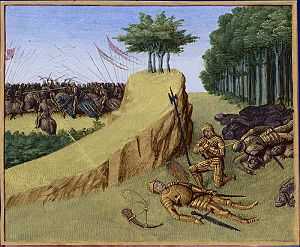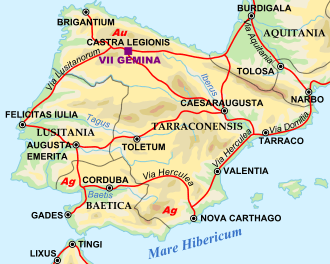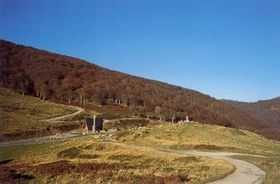Battle of Roncevaux Pass
| Battle of Roncevaux Pass | |||||||
|---|---|---|---|---|---|---|---|
| Part of Charlemagne's campaign in the Iberian Peninsula | |||||||
 The death of Roland at the Battle of Roncevaux, from an illustrated manuscript, 1455–1460 | |||||||
| |||||||
| Belligerents | |||||||
| Franks | Vascones | ||||||
| Commanders and leaders | |||||||
|
Charlemagne Roland †, Eginhard, Anselmus |
Unknown (speculated: Duke Lop of Vasconia) | ||||||
| Strength | |||||||
| Unknown (army rearguard) | Unknown (guerrilla party) | ||||||
| Casualties and losses | |||||||
| Massacre of the Frankish rearguard but safety for the main force | Unknown | ||||||
The Battle of Roncevaux Pass (French and English spelling, Roncesvalles in Spanish, Orreaga in Basque) was a battle in 778 in which Roland, prefect of the Breton March and commander of the rear guard of Charlemagne's army, was defeated by the Basques. It was fought at Roncevaux Pass, a high mountain pass in the Pyrenees on the border between France and Spain.
Over the years, the battle was romanticized by oral tradition into a major conflict between Christians and Muslims, when in fact both sides in the battle were Christian.[1] The legend is recounted in 11th century The Song of Roland, which is the oldest surviving major work of French literature, and in Orlando Furioso, which is one of the most celebrated works of Italian literature.
Background
With the rise of the Carolingians and Pepin the Short's war on Aquitaine, the Duchy of Aquitaine led by Waifer was defeated and a program of Frankish penetration into the duchy ensued under Charlemagne. The Basques (Vascones, Wascones) of the Duchy of Vasconia, one of the mainstays of the Aquitanian army, submitted to Pepin in 766 and 769, but the territory south of the Garonne remained largely unscathed and self-governed—Duke Lupus cited. However, as of 778 Charlemagne expanded Frankish takeover of Aquitaine to present-day Gascony by appointing trusted Franks and Burgundians as well as Church officials in key regional positions and (re-)establishing counties, such as Fezensac, Bordeaux, and Toulouse, on the left banks of the Garonne. Charlemagne's colonization attempts bitterly displeased the Basques.
The plot
See Abbasid-Carolingian alliance for more.
Sulayman al-Arabi, the pro-Abbasid Wali (governor) of Barcelona and Girona, sent a delegation to Charlemagne in Paderborn, offering his submission, along with the allegiance of Husayn of Zaragoza and Abu Taur of Huesca in return for military aid.[2] Their masters had been cornered in the Iberian peninsula by Abd ar-Rahman I, the Umayyad emir of Córdoba. The three rulers also conveyed that the caliph of Baghdad, Muhammad al-Mahdi, was preparing an invasion force against Abd ar-Rahman.[3]
Seeing an opportunity to extend Christendom and his own power and believing the Saxons to be a fully conquered nation, Charlemagne agreed to go to Spain. It seems that al-Arabi induced him to invade Al Andalus by promising him an easy surrender of its Upper March, of which Zaragoza was the capital. The King did not make up his mind until the winter, but he finally decided to launch an expedition into the Iberian peninsula the next year.
Following the sealing of this alliance at Paderborn,[4] Charlemagne marched across the Pyrenees in 778 "at the head of all the forces he could muster".[5] Charlemagne led the Neustrian army over Vasconia into the Western Pyrenees, while the Austrasians, Lombards, and Burgundians passed over the Eastern Pyrenees through Catalonia. His troops were welcomed in Barcelona and Girona by Sulayman al-Arabi.[6] As he moved towards Zaragoza, the troops of Charlemagne were joined by troops led by al-Arabi.[7]
Abd ar-Rahman of Córdoba sent his most trusted general, Thalaba Ibn Obeid, to take control of the possibly rebellious city and to prevent the Frankish invasion. Husayn and Ibn Obeid clashed repeatedly; eventually Husayn managed to defeat and to imprison Ibn Obeid.
Reinforced in his autonomous position, Husayn became reluctant to yield his new privileged status to the Frankish monarch and refused to surrender the city to Charlemagne, claiming that he had never promised Charlemagne his allegiance. He seems to have tried to appease Charlemagne by giving him the prisoner General Ibn Obeid and a large tribute of gold, but Charlemagne was not easily satisfied, putting Sulayman al-Arabi in chains.
Meanwhile, the force sent by the Baghdad caliphate seems to have been stopped near Barcelona.[8] After a month of siege at Zaragoza, Charlemagne decided to return to his kingdom.[9]
The retreat
As the Frankish army retreated towards Pamplona they suffered an ambush led by the relatives of al-Arabi. Sulayman al-Arabi was liberated and brought to Zaragoza, where both conspirators jointly resisted a new attack by Abd ar-Rahman. Sulayman al-Arabi would eventually be murdered by al Ansari.
Charlemagne also suffered an attack from the Basques in central Navarra. After stopping at Pamplona, Charlemagne ordered the walls of this strategic city be destroyed, possibly fearing that it could be used by the Basques in future rebellions. Some primary sources suggest that he destroyed the city altogether.[10] Thereafter, Charlemagne marched for the Pyrenees and home. In the mountains, the army's rear guard was attacked.
The battle
| History of the Basques |
|---|
| Prehistory and Antiquity |
| Basque Prehistory |
| Basques during Antiquity |
| Middle Ages |
| Duchy of Cantabria |
| Duchy of Vasconia |
| County of Vasconia |
| Battle of Roncevaux Pass (778) |
| Kingdom of Navarre |
| Banu Qasi |
| Lordship of Biscay |
| Basque party wars |
| Modern Age |
| Spanish conquest of Iberian Navarre |
| Basque witch trials |
| Guipuzcoan Company of Caracas |
| Carlist Wars |
| Basque nationalism |
| Basque conflict |
| Monarchs and Sovereign Families |
| Dukes of Vasconia and Gascony |
| Kings of Pamplona and Navarre |
| Lords of Biscay |
| House of Haro |
| Topical |
| Basque law |
| History of Basque whaling |
| Basque culture |
| Basque diaspora |
| Basque literature |
| Politics of the Basque Country |
| ETA |
| Timeline of Basque history |
| Basque portal |
The battle itself took place in the evening of Saturday 15 August 778, causing numerous losses among the Frankish troops, including several most important aristocrats and the sack of the baggage, probably with all the gold given by the Muslims at Zaragoza. After their success, the attackers took advantage of the night to flee.
The sources are somewhat contradictory, yet the second version of the Annales Regii (falsely attributed to Eginhard) reads:[11]
Having decided to return, [Charlemagne] entered the mountains of the Pyrenees, in whose summits the Vascones had set up an ambush. They attacked the rearguard, causing confusion which spread to all the army. And, while the Franks were superior to the Vascones both in armament and in courage, the roughness of the terrain and the difference in the style of combat made them generally weaker. In this battle were killed the majority of the paladins that the King had placed in command of his forces. The baggage was sacked, and suddenly the enemy vanished, thanks to their knowledge of the terrain. The memory of the injury so produced overshadowed in the King's heart that of the feats done in Hispania.
The Vita Karoli mentions the names of the most important paladins killed among many others: Eggihard, Mayor of the Palace, Anselmus, Palatine Count and Roland, Prefect of the March of Brittany.[12]
The Basque army
The guerrilla army of the Basques is not well known. A later source, the anonymous Saxon Poet, talks of the Basque spears, which fits with the Pyrenean and Basque tradition that would be present much later among the almogavars. A typical such mountain warrior would have two short spears and a knife or short sword as his main weapons, and would not normally wear armour.
Pierre de Marca, a Béarnese author, suggests that the attackers were a reduced number of mostly local Low Navarrese, Souletines, and Baztanese, whose main motivation may well have been plunder. Nevertheless he also suggests that the Duke of Vasconia, Lop, may have been their commander.[13] This opinion is also held by the authors of the General History of Languedoc who claim that Duke Lop was the leader of the Gascons (cited always as Wascones) that attacked Charlemagne,[14] who had serious reasons to oppose Carolingian expansion into Vasconia after the Franco-Aquitanian war (760–769).[15]
The presence of people from other areas beyond those mentioned by de Marca is very likely anyhow. It is difficult to imagine why Bazatanese were there and not, for instance, the people of the nearby Aezkoa or Salazar valleys. There are even attributions to Guipuzcoans, such as a dedication in a chapel of Pasaia that gives thanks to Our Lady of Piety because of her support to their alleged participation in this battle (although the date mentioned (814) may be that of the Second Battle of Roncevaux: see below).
Location


There have been many different theories as to where this battle actually took place, some suggesting various places in the High Pyrenees ranging from Navarre and Aragon to as far as Catalonia. The mainstream opinion is that the battle took place somewhere not far from Roncevaux itself, as it is not just on one of the easiest routes but also the traditional one. Indeed, the Roman road "Via ab Asturica Burdigalam" which started in Castra Legiones (current León) and went to Benearnum, crossed the Pyrenees through Roncevaux. However, the traditional Roman road (also called the Route of Napoleon) followed a route different from the modern one, not crossing at Ibañeta (the traditional location) but heading up eastwards and crossing instead the Lepoeder and Bentartea passes—next to the mount Astobizkar—not far from the mount Urkulu, identified as the Summum Pyreneum of the classic Roman sources. Several authors (Narbaiz, Jimeno Jurio) have pinpointed the actual scene of the clash in the narrow passages of the above spots.[16] However, that may have been the spot of the ambush, but the baggage train commanded by Roland was pushed to the valley, where the Basques engaged them in open battle.[17]
Another possible location that has been suggested for the battle is that of the Selva de Oza pass, in the valley of Hecho, on the border between Aragon and Navarre, since the old Roman road called "Via Caesar Augusta" that led from Caesaraugusta (Zaragoza) to Benearnum (Béarn) crosses the Pyrenees there. Since Charlemagne was retreating from Caesaraugusta, it has been seen as a possible location. Other than tradition, that points towards Roncesvaux as the place of the battle, the main argument provided against the Selva de Oza location is that according to the chronicles, Charlemagne retreated from Pamplona after arriving there from Zaragoza. This would suggest that he took the "Ab Asturica Burdigalam" road which passed through Pamplona, and not retrace his way back to the east, where Hecho lies. However, when physical descriptions of the battle site are taken on account, the Selva de Oza location seems to fit descriptions that tell about gorge-like passages wide enough for an army to pass easily and with several high vantage points from which to attack the enemy. Nevertheless, the Roncesvaux and Selva de Oza passes are only about 30 kilometers apart.
Other locations have also been suggested, some as far away as in Catalonia, indicating that it is not established that Charlemagne took any of the Roman roads when retreating, nor that he retreated directly from Pamplona. Indeed, the routes that crossed the Pyrenees through Catalonia (crossing the valley of Llívia) are traditionally the easiest, though a Basque attack taking place so far from their heartland is seen as dubious.
Consequences
The Franks failed in capturing Zaragoza and suffered significant losses at the hands of the Basques. They would only be able to establish the Marca Hispanica a decade later, when Barcelona was finally captured. Zaragoza remained an important Muslim city, capital of the Upper March and later of an independent emirate, until the 11th century.
Defenceless Pamplona was captured by the Muslims soon after and held by them for some years, until in 798–801 a rebellion expelled them as well and helped to consolidate the Banu Qasi realm and eventually the constitution of the independent Kingdom of Pamplona in 824.

Legend
Over the years, this battle was romanticized by oral tradition into a major conflict between Christians and Muslims, although, in fact, both sides in the battle were Christian. In the tradition, the Basques are replaced by a force of 400,000 Saracens. (Charlemagne did fight the Saracens in Iberia, though not in the Pyrenees.) The Song of Roland, which commemorates the battle, was written by an unknown poet of the 11th century. It is the earliest surviving of the chansons de geste or epic poems of medieval France in the langue d'oïl, in what would become the French language. There is a tombstone near the Roncevaux Pass commemorating the area where it is traditionally held that Roland died. Several traditions also state that Roland was slain by a child who, in time, would become the very first king of Navarre: Iñigo Arista.
There is an alternate medieval Iberian legend involving Bernardo del Carpio, a medieval Leonese hero, whom some stories hold to be the vanquisher of Roland at Roncevaux.
The 812 expedition and the Second Battle of Roncevaux
In the year 812 there was a second ambush attempt in the same pass, which ended in stalemate due to the Franks taking greater precautions than they had in 778, i.e. they took Basque women and children as hostages.
In the year 824 was the possibly more important Second Battle of Roncevaux, where counts Eblus and Aznar, Frankish vassals, were captured by the joint forces of Iñigo Arista's Pamplona and of the Banu Qasi, consolidating the independence of both Basque realms.[18]
Value for comparative history
In the case of the Battle of Roncevaux, historians possess both the description of an event by contemporary and fairly reliable sources and the depiction of the same event resulting from centuries of an oral tradition, in which it was magnified to epic proportions and changed almost unrecognizably.
The ability here to compare both accounts, and trace how an actual historical event is transformed into legend, is useful for the study of other events of which the only existing account is one deriving from centuries of oral tradition, and in which historians need to try to reconstruct the actual historical facts and separate them from later myth (for example, Homer's depiction of the Trojan War).
See also
- Duchy of Vasconia
- Kingdom of Navarre
- La Brèche de Roland
The battle is also referenced in the song "Roncevaux" by Van der Graaf Generator, originally recorded in 1972 but only released in rather rough form many years later on the album Time Vaults.[19]
References
- ↑ Murrin, Michael (1994). History and Warfare in Renaissance Epic. Chicago: University of Chicago Press. ISBN 0226554031.P. 25
- ↑ Lewis, David L. (2008). God’s Crucible: Islam and the Making of Europe, 570 to 1215 (1st ed.). New York: W.W. Norton. ISBN 9780393064728., p. 244
- ↑ Lewis, p. 244
- ↑ Lewis, p.245
- ↑ Lewis, p.246
- ↑ Lewis, p.253
- ↑ Lewis, p.246
- ↑ Lewis, p.249
- ↑ Lewis, p.249
- ↑ Lewis, p.249
- ↑ Narbaitz, Pierre. Orria, o la batall de Roncesvalles. 778. Elkar, 1979. ISBN 84-400-4926-9
- ↑ Thorpe, Lewis Two Lives Of Charlemagne ISBN 0-14-044213-8
- ↑ Pierre de Marca, Historie du Béarn (quoted by Narbaitz, op.cit.)
- ↑ Devic and Vaissette, Historie Genérale du Languedoc, 1872 (quoted by Narbaitz, op.cit.),
- ↑ Lewis, Archibald R. (1965). The Development of Southern French and Catalan Society, 718–1050. Austin: University of Texas Press. pp. 38–50. Retrieved March 26, 2013.
- ↑ Narbaitz, Pierre (1979). Orria o la batalla de Roncesvalles: 15 de Agosto del 778. Pamplona: Ediciones Vascas. ISBN 978-84-400-4926-1. OCLC 7435876.
- ↑ Collins, Roger (1990). The Basques (2nd ed.). Oxford, UK: Basil Blackwell. p. 122. ISBN 0631175652.
- ↑ Ducado de Vasconia (Auñamendi Encyclopedia)
- ↑ "Time Vaults". Van der Graaf Generator. Retrieved 2013-03-27.
External links
| Wikimedia Commons has media related to Battle of Roncevaux Pass. |
- Earliest manuscript of the Chanson de Roland, readable online images of the complete original, Bodleian Library MS. Digby 23 (Pt 2), La Chanson de Roland, Anglo-Norman, 12th century, ?2nd quarter.
- The Song of Roland, trans. John O'Hagan
- "Battle of Roncesvalles" by Thomas Bulfinch (1796–1867), from Legends of Charlemagne
- Romances de Bernardo del Carpio (Spanish)
- Roncesvalles carolingio y jacobeo (Spanish)